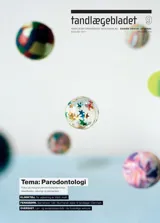Aspekter af marginal parodontitispatogenese
Forståelsen af marginal parodontitis patogenese udvikles konstant i takt med den øgede indsigt i immunsystemets funktioner. Bakterier i den dentale plak kan i sig selv iværksætte nedbrydningsprocesser, men den overvejende del af den parodontale nedbrydning menes at ske indirekte ved bakteriernes igangsætning af nedbrydningsprocesser via inflammationssystemet. Om end disse processer er komplekse, er dele af dem afklaret. Værtsorganismens egne inflammatoriske reaktioner kan påvirkes af talrige forhold, herunder de tilstedeværende mikroorganismers egenskaber, værtsorganismens genetiske baggrund, medicinske sygdomme og livsstilsfaktorer. De herved etablerede individuelle modifikationer af den inflammatoriske reaktion kan formentlig forklare den betydelige variation i sygdomstilbøjelighed. Det spændende ved forståelsen af nedbrydningsprocesserne er, at der muligvis kan udvikles nye biologiske behandlingsmetoder, baseret på en medicinsk indgriben med det formål at begrænse de kataboliske dele af inflammationen. En sådan type behandling er udviklet for reumatoid arthritis og kan derfor også tænkes for aggressiv marginal parodontitis, om end der endnu ikke er overbevisende resultater.
Pathogenesis of periodontitis
The understanding of the pathogenesis of periodontitis is ever emerging along with the growth of knowledge on the function of the immune system. Bacteria in dental plaque are themselves able to directly break down the periodontal supportive tissues, but the major periodontal destruction is suspected to be carried out by inflammatory processes as an indirect result of the bacterial challenge. Although complex, these processes are to some extent established knowledge today. The inflammatory reactions of the host may be influenced by several factors such as properties of the local microorganisms, genetics, medical diseases, and life style. Individual modifications of the inflammatory processes thereby established are most likely responsible for the major variation in periodontal disease susceptibility. An exciting aspect of understanding the degradation processes is that it may well be possible to interfere with these processes by medical treatment to limit the catabolic part of the inflammation, thereby preventing or ameliorating the aggressive destruction of the periodontal tissues. Since such a treatment regimen has been established for rheumatoid arthritis it may be possible to adapt this for aggressive periodontitis in the future.


